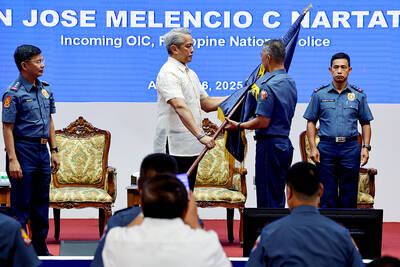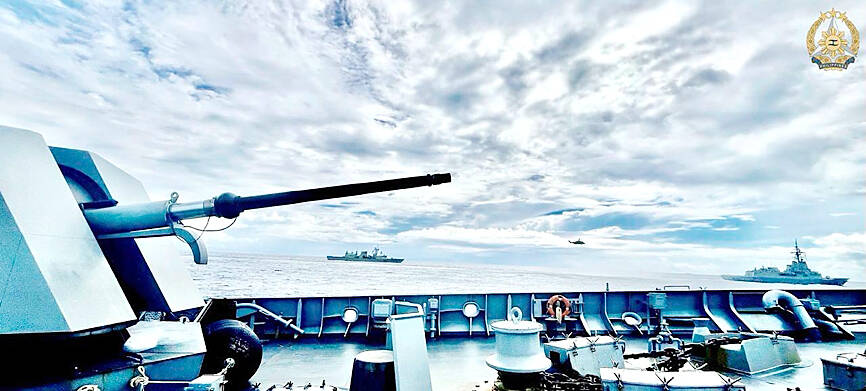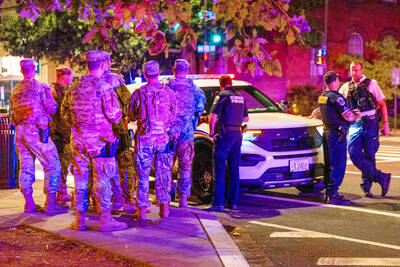In a clearing by a sugar cane field a few kilometers from the former US Air Force base at Clark in the Philippines, stands a life-size statue of a Japanese kamikaze pilot.
In any other country that was occupied by the Japanese such a monument would raise howls of protest -- but in the Philippines the worst it has elicited is a few grumbles.

PHOTO: AFP
The sculpture stands on what used to be the east Mabalacat airfield, 80km northwest of Manila, where 60 years ago Japan unleashed its suicide squadrons in a last desperate bid to turn the tide of defeat.
According to local tourism official Guy Hilbero, the aim of the statue is to promote peace "using the lessons of war."
"It is not a memorial glorifying the kamikaze pilots," he said.
"I suppose a lot of foreigners would find that difficult to understand considering we were once occupied by the Japanese," he said. "But we Filipinos are a very forgiving people. At some point you have to forgive and move on."
He said the statue, which was unveiled earlier this week in a simple, low key ceremony in front of some 200 local and Japanese officials, should be seen as a symbol.
"A symbol for all that is wrong with war. The point being that no one wins," Hilbero said.
The original design for the statue depicted a kamikaze clutching a sword and proudly leaning on a 112.5kg bomb but Hilbero didn't think it was appropriate.
Colonel Rafael Estrada, 87, founder and chairman of the veterans group Defenders of Bataan and Corregidor said: "The site is where the Kamikazes were born. That is a historical fact.
"I have no problem with that but to mark it with a full size statue of a Kamikaze pilot is, in my opinion, not right," Estrada said.
According to Ronnie dela Cruz who runs the historical society in the town of Bamban, next door to Mabalacat, the statue is a disgrace.
"It is a symbol of military power, not peace. It glorifies the kamikaze pilots and goes beyond being just an historical marker," he said.
In the final 10 months of the war, some 7,465 kamikaze flew to their deaths, 120 US ships were sunk with many more damaged and 3,048 allied sailors were killed and another 6,025 wounded.
Today, nothing remains of the airfield except for a 500m2 plot of land donated by a farmer which has been turned into a small memorial park. In 1998 the local government passed a resolution declaring the park on what was the kamikaze east airfield a "peace memorial."
Following the Leyte landings in the eastern Visayas islands by the US and the return of General Douglas MacArthur to the occupied Philippines on Oct. 20, 1944, the Japanese found themselves heavily outnumbered on the ground, in the air and on the sea.
Vice Admiral Takijiro Ohnishi met with his officers of the First Air Fleet at what was then the Mabalacat East Airfield on Oct. 18, 1944, two days before the US invasion to outline his plan for victory.
According to Rikihei Inoguchi and Tadashi Nakajima in their book The Divine Wind, Ohnishi said: "In my opinion there is only one way of assuring that our meager strength will be effective to a maximum degree ... That is to organize suicide attack units composed of Zero fighters armed with 250kg bombs, with each plane to crash-dive into an enemy aircraft carrier."
Inoguchi once said in an interview: "No one welcomes death but it is more understandable if one bears in mind that, considering the heavy odds that our fliers faced in 1944, their chances of coming back alive from any sortie against enemy carriers was very slim, regardless of the attack method employed."
The first kamikaze unit was born on Oct. 20 and was led by 23-year-old Lieutenant Yukio Seki. On Oct. 25, Seki and four other pilots, aged from 19 to 20, climbed aboard their Zero flying bombs and took off from the Mabalacat. Three hours later Seki flew his aircraft into the flight deck of the aircraft carrier USS St. Lo. The ship sank within 20 minutes with a loss of 114 of its 860 crew ... and the world's first human flying bomb had been born.

Philippine President Ferdinand Marcos Jr has fired his national police chief, who gained attention for leading the separate arrests of former Philippine president Rodrigo Duterte on orders of the International Criminal Court and televangelist Apollo Carreon Quiboloy, who is on the FBI’s most-wanted list for alleged child sex trafficking. Philippine Executive Secretary Lucas Bersamin did not cite a reason for the removal of General Nicolas Torre as head of the 232,000-member national police force, a position he was appointed to by Marcos in May and which he would have held until 2027. He was replaced by another senior police general, Jose

STILL AFLOAT: Satellite images show that a Chinese ship damaged in a collision earlier this month was under repair on Hainan, but Beijing has not commented on the incident Australia, Canada and the Philippines on Wednesday deployed three warships and aircraft for drills against simulated aerial threats off a disputed South China Sea shoal where Chinese forces have used risky maneuvers to try to drive away Manila’s aircraft and ships. The Philippine military said the naval drills east of Scarborough Shoal (Huangyan Island, 黃岩島) were concluded safely, and it did not mention any encounter with China’s coast guard, navy or suspected militia ships, which have been closely guarding the uninhabited fishing atoll off northwestern Philippines for years. Chinese officials did not immediately issue any comment on the naval drills, but they

POWER CONFLICT: The US president threatened to deploy National Guards in Baltimore. US media reports said he is also planning to station troops in Chicago US President Donald Trump on Sunday threatened to deploy National Guard troops to yet another Democratic stronghold, the Maryland city of Baltimore, as he seeks to expand his crackdown on crime and immigration. The Republican’s latest online rant about an “out of control, crime-ridden” city comes as Democratic state leaders — including Maryland Governor Wes Moore — line up to berate Trump on a high-profile political stage. Trump this month deployed the National Guard to the streets of Washington, in a widely criticized show of force the president said amounts to a federal takeover of US capital policing. The Guard began carrying

Ukrainian drone attacks overnight on several Russian power and energy facilities forced capacity reduction at the Kursk Nuclear Power Plant and set a fuel export terminal in Ust-Luga on fire, Russian officials said yesterday. A drone attack on the Kursk nuclear plant, not far from the border with Ukraine, damaged an auxiliary transformer and led to 50 percent reduction in the operating capacity at unit three of the plant, the plant’s press service said. There were no injuries and a fire sparked by the attack was promptly extinguished, the plant said. Radiation levels at the site and in the surrounding